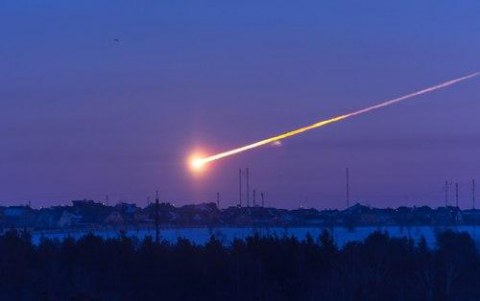Courtesy of The Stringer - thestringer.com.au
http://thestringer.com.au/a-meteorite-hits-russia-while-an-asteroid-miss...
Gerry Georgatos - A meteor struck Russian soil, injuring people while an asteroid narrowly missed the Earth. The meteor exploded some 10,000 metres above the Ural city of Chelyabinsk engorging the sky with nearly 500 kilotons of energy – 30 times the size of the of the Hiroshima atomic bomb blast. More than a 1,000 people were injured, including 200 children. A thousand buildings were damaged as the explosion sent a flock of fireballs into the earth followed by a shockwave and vibrations that knocked people to the ground.
2,000 emergency workers came to the fore to make as many repairs as possible to the buildings in the bid to offset the permeations from the freezing temperatures which at night sink to as low as minus 20 degrees Celsius.
Russian State television was told by District Police Chief Marat Minzagirov, “We have taken all the facilities under our control.”
A chunk of meteor plunged into the towns nearby Lake Chebarkul which is frozen at this time of year.
Search teams near and around the town have found small pieces, less than one centimetre wide, which they believe are fragments of the meteorite. Meteorite hunters are scouring the frozen countryside with buyers prepared to pay up to $10,000 USD for an authentic piece of the meteorite.
A few sites even offered peculiar-shaped rocks for sale, but scientists cautioned that none were likely to be the genuine article.
The meteor explosion was captured on film by many as a cosmic incident in the Ural skies and was Russia’s most noteworthy extra-terrestrial event since Tunguska in 1908 – in which scientists believed an asteroid like impact slashed across Siberia levelling forests and tearing up the landscape.
NASA scientists confirmed that the critical mass energy released into the atmosphere above the Ural town from the meteorite was 30 times greater than Hiroshima bomb blast.
ABC News Kirit Radia released the following conversation from NASA with Paul Abell:
“This was the biggest meteor to hit since the 1908 impact that flattened a large part of Siberia. NASA’s preliminary calculation is that this thing weighed in at 7,700 tonnes.”
“The blasts we hear in the videos are not sonic booms caused by the meteor breaking the sound barrier. Rather it is the meteor exploding in the atmosphere. Subsequent booms are the smaller fragment breaking up.”
“It was the force of those explosions that blasted out the windows.”
“This thing was moving very fast as it entered the atmosphere. About 40,000 miles per hour.”
The meteor strike was preceded only hours earlier by an asteroid effectively skimming past the earth at the relatively close proximity of only 27,700 kilometres. The magnitude of the closeness of the asteroid is unprecedented in recent times. Contextually, one can imagine how close it came to the Earth when we consider it was closer to the Earth than many of our orbital satellites. Had it been half the distance closer there would have generated vibratory effects, and had the asteroid struck the Earth, wherever, the impacts would have impacted indescribable effects upon its target, including the possibility of impinging upon the Earth’s axial tilt and rotational movement. NASA estimates an asteroid hits the Earth every 1,200 years.
Russia’s Foreign Affairs committee chief, Alexei Pushkov said that both the meteorite and asteroid should be a wake-up call to humanity. “Instead of fighting on Earth, people should be creating a joint system of asteroid defence.”
“Instead of creating a militarised European space defence system, the United States should join us and China in creating an Anit-Asteroid Defence System.”
The asteroid, the size of an Olympic swimming pool, was the closest ever recorded for its size. The asteroid was 45 metres wide and its closest approach was over the eastern Indian Ocean. The best images were secured from the Gingin Observatory in Western Australia. Images of the white streak were tracked live by the Observatory. The asteroid remained outside the Earth’s atmosphere however was closer to the Earth than most of the weather and communication satellites.
The 45 metre wide asteroid would not have wiped out humanity or other species however would have made an impact. The asteroid that is presumed to have wiped out the dinosaurs among other life forms is believed to have been 10 kilometre wide. Nevertheless, this latest asteroid had it hit the Earth could have wiped out a large urban area had it struck it.
Astronomers had only discovered the asteroid’s pending presence in February 2012 and named it 212 DA14. Astronomers have spotted some nearly 10,000 celestial bodies coming into relative close proximity of the Earth. It is believed they have only spotted ten per cent of the celestial bodies that scoot and skirt past the Earth since having the capacity to capture their looming presence.
LINKS:
YouTube clip of the meteor above the sky of the Russian Ural town
http://www.abc.net.au/news/2013-02-17/russia-cleans-up-after-meteor-blas...
ABC news coverage:
http://www.abc.net.au/news/2013-02-16/russia-cleans-up-after-extraordina...
Live feed images from Gingin Observatory:
http://www.youtube.com/watch?v=t_rM1KSzNuM

